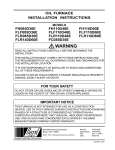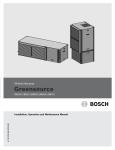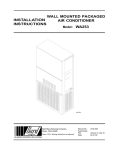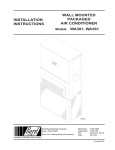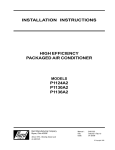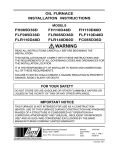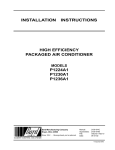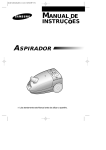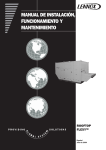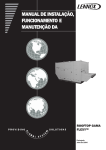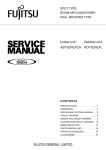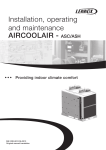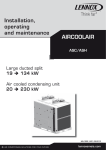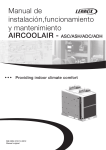Download Baldor GLC40 Portable Generator User Manual
Transcript
OIL FURNACE INSTALLATION INSTRUCTIONS MODELS FH085D36F FLF085D36F FLR085D36F FLR140D60F FH110D48F FLF110D48F FLR110D48F FC085D36F FH110D60F FLF110D60F FLR110D60F WARNING READ ALL INSTRUCTIONS CAREFULLY BEFORE BEGINNING THE INSTALLATION. THIS INSTALLATION MUST COMPLY WITH THESE INSTRUCTIONS AND THE REQUIREMENTS OF ALL GOVERNING CODES AND ORDINANCES FOR THE INSTALLATION LOCATION. IT IS THE RESPONSIBILITY OF INSTALLER TO KNOW AND UNDERSTAND ALL OF THESE REQUIREMENTS. FAILURE TO DO SO COULD CREATE A HAZARD RESULTING IN PROPERTY DAMAGE, BODILY INJURY OR DEATH. FOR YOUR SAFETY DO NOT STORE OR USE GASOLINE OR OTHER FLAMMABLE VAPORS OR LIQUIDS IN THE VICINITY OF THIS OR ANY OTHER APPLIANCE. IMPORTANT NOTICE THIS FURNACE IS NOT INTENDED FOR USE AS A CONSTRUCTION HEATER. USE OF THIS FURNACE DURING CONSTRUCTION AND FINISHING PHASES OF A STRUCTURE IS CONSIDERED AS "OPERATION IN A CORROSIVE ATMOSPHERE" AND "UNUSUAL, NEGLIGENT OR IMPROPER USE" AND AS SUCH ARE CONSIDERED EXCLUSIONS BY THE BARD MANUFACTURING COMPANY LIMITED WARRANTY. WARNING CARBON MONOXIDE POISONING HAZARD FAILURE TO FOLLOW THIS WARNING COULD RESULT IN PERSONAL INJURY OR DEATH. Carbon Monoxide is invisible, orderless and toxic! Bard Manufacturing recommends a carbon monoxide alarm in your home, even if you do not own a gas appliance. Locate the carbon monoxide alarm in the living area of your home and away from doorways to attached garages. Follow the alarm manufacturer’s instructions included with the alarm. Bard Manufacturing Company, Inc. Bryan, Ohio 43506 Since 1914...Moving ahead just as planned. Manual: Supersedes: File: Date: 2100-422M 2100-422L VOL. I, TAB 3 11-21-11 Manual 2100-422M Page 1 of 42 CONTENTS Getting Other Information and Publications ........ 3 Installation and Operating Instructions Equipment Selection ............................................. 4 Locating the Furnace ............................................ 4 Installing the Furnace ........................................... 8 Duct Work ............................................................. 8 Installing a Cooling Unit ........................................ 8 Wiring .............................................................. 9 Oil Line Piping ..................................................... 12 Beckett AFG Oil Burner .............................. 12 & 13 Beckett “CleanCut” Oil Pump .............................. 13 Beckett Solid State Igniter ................................... 13 Beckett R7184B Primary Control ........................ 13 Beckett R7184B Primary Operational Guide ...... 14 Beckett GeniSys 7505 ................................ 14 – 17 Burner States, Reset Button Op., Priming the Pump, Cad Cell Resistance Indicator, Reset Restricted Lockout Filters Lo-Boy Models – Filter Locations ...................... 33 Maintenance Lubrication .......................................................... 34 Inspect Air Filter .................................................. 34 Final Inspection and Test .................................... 34 Service Hints ....................................................... 34 Combination Combustion Chamber/Burner Mounting System ................................................ 35 To Remove Burner Only ..................................... 36 To Remove Entire Combustion Chamber Mounting System ................................................ 36 Common Causes of Trouble ............................... 37 Care of Finish ..................................................... 37 Cleaning of the Heat Exchanger ......................... 37 Blower System Resistance Charts ................. 38-39 Wiring Diagrams ............................................ 40-42 Burner Set up and Adjustments ............ 19, 20 & 21 Short Form Adjustment Procedure ..................... 21 Combustion Air Requirements ............................ 25 Louvers and Grilles ............................................. 30 Venting Options .................................................. 30 Thermostat .......................................................... 30 TABLES Table 1 Table 2 Table 3 Table A Table B Table 4 Table 5 Minimum Clearances ............................. 4 Dimensions FLF/R Models ................... 5 Electrical Data ........................................ 9 Reset Button Operation ....................... 15 Status Lights ........................................ 15 Furnace Data ....................................... 19 Correlation of % of CO2, O2 and Reserve Air .......................................... 24 Table 6 No. 2 Fuel Oil Efficiency Chart ............. 24 Table 7 Recommended Start-Up Settings ........ 24 Table 8 Sq.Ft. Required as Unconfined Space ............................... 27 Table 9 Minimum Ventilation Openings ............ 28 Table 10 Temperature Rise Ranges, Limit Control Settings, and Heating Blower Speeds ....................... 31 Table 11 Filter Sizes for Oil Furnaces ................ 32 FIGURES Figure 1 Figure 2 Figure 3 Figure 4 Figure 5 Figure 6 Figure 7 Figure 8 Figure 9 Figure 10 Figure 11 Figure 12 Figure 13 Figure 14 Figure 15 CHARTS Chart 1 Chart 2 Chart 3 Chart 4 Chart 5 Chart 6 Chart 7 Chart 8 FH085D36F Data ................................. 38 FH110D48F Data ................................. 38 FH110D60F Data ................................. 38 FLF/FLR085D36F Data ....................... 38 FLF/FLR110D48F Data ....................... 38 FLF/FLR110D60F Data ....................... 38 FLR140D60F Data ............................... 39 FC085D36F Data ................................. 39 Manual 2100-422M Page 2 of 42 Figure 16 Figure 17 Figure 18 Figure 19 Figure 20 FLF/R Models Dimensions ................ 5 FH Models Dimensions ..................... 6 FC Models Dimensions ..................... 7 Typical Unit Setup - FLF .................. 10 Typical Flue Installation Requirements - FLF ........................ 11 Typical Single Inside Tank Installation ............................... 12 Electronic Blower Control ................ 18 Typical Smoke-CO2 Characteristic .. 22 Pressure Gauge Connection to Bleed Port ....................................... 23 Electrode Adjustments ..................... 25 Combustion Air Boot Assembly ....... 26 All Air From Inside Building ............. 27 All Air From Outdoors ...................... 28 All Air From Outdoors Through Ventilated Attic ................................. 29 All Air From Outdoors - Inlet Air From Ventilated Crawl Space and Outlet Air to Ventilated Attic ............. 29 Typical Installation of FR26 and FR27 . Filter Rack ....................................... 32 Typical Installation of FR25 Filter Kit .................................................... 32 Filter Installation - Lo-Boy Models ... 33 Removal of Burner Only .................. 35 Removal of Entire Combustion Chamber Mounting System ............. 36 GETTING OTHER INFORMATION and PUBLICATIONS These publications can help you install the furnace. You can usually find these at your local library or purchase them directly from the publisher. Be sure to consult current edition of each standard. FOR MORE INFORMATION, CONTACT THESE PUBLISHERS: ACCA Air Conditioning Contractors of America 1712 New Hampshire Ave. N.W. Washington, DC 20009 Telephone: (202) 483-9370 Fax: (202) 234-4721 ANSI American National Standards Institute 11 West Street, 13th Floor New York, NY 10036 Telephone: (212) 642-4900 Fax: (212) 302-1286 ASHRAE American Society of Heating Refrigerating, and Air Conditioning Engineers, Inc. 1791 Tullie Circle, N.E. Atlanta, GA 30329-2305 Telephone: (404) 636-8400 Fax: (404) 321-5478 NFPA National Fire Protection Association Batterymarch Park P.O. Box 9101 Quincy, MA 02269-9901 Telephone: (800) 344-3555 Fax: (617) 984-7057 National Fuel Gas Code .............. ANSI Z223.1/NFPA54 National Electrical Code ......................... ANSI/NFPA 70 Standard for the Installation ................. ANSI/NFPA 90A of Air Conditioning and Ventilating Systems Standard for Warm Air ........................ ANSI/NFPA 90B Heating and Air Conditioning Systems Standard for Chimneys, Fireplaces, Vents ...... NFPA 211 and Solid Fuel Burning Appliances Load Calculation for .............................. ACCA Manual J Residential Winter and Summer Air Conditioning Duct Design for Residential ................. ACCA Manual D Winter and Summer Air Conditioning and Equipment Selection Manual 2100-422M Page 3 of 42 INSTALLATION and OPERATING INSTRUCTIONS EQUIPMENT SELECTION LOCATING THE FURNACE An accurate heating load calculation must be conducted using American Society of Heating, Refrigeration and Air Conditioning Engineers (ASHRAE) or Air Conditioning Contractors of America (ACCA) manuals. Do not add a large safety factor above the calculated value. If the calculated heating load requirement exceeds the heating capacity rating of a given model, use only the next larger size available. Never increase by any more than absolutely necessary based upon available equipment heating capacities. Always select based upon heat capacity (output), never use input capacities. When installing the furnace be sure to provide adequate space for easy service and maintenance. Locate the furnace as close to the chimney as practical, giving consideration to the accessibility of the oil burner, controls, and blower for service. Allow a minimum of 24 inches at front of furnace for servicing oil burner. Allow adequate room for filter and blower maintenance. Clearance from combustible material as stated on the furnace and repeated in Table 1 must be maintained. For damp basement installations, a raised concrete pad is recommended. This will help keep the bottom of the furnace dry and reduce the risk of rusting. NOTE: It is the personal responsibility and obligation of the purchaser to contract a qualified installer to assure that installation is adequate and is in conformance with governing codes and ordinances. An oil burner must have a generous supply of combustion air to operate properly. The flow of combustion and ventilating air must not be obstructed from reaching the furnace. See “Combustion Air Requirements” section. The furnace area must be kept clear and free of combustible materials, gasoline and other flammable vapors and liquids. This unit is not designed for mobile home or trailer installations. Always install furnace in a level position. TABLE 1 MINIMUM CLEARANCES Minimum Installatio n C learnaces — Inches Furnace P lenum Minimum Service C learances Fro nt B ack Sides To p Sides 1 D uct Flue P ipe Flo o r Fro nt B ack Sides FH085D 36F FH110D 48F FH110D 60F 4 4 4 1 1 1 2 2 2 2 2 2 2 2 2 2 2 2 9 9 9 C C C 24 24 24 — — — — — — F LF 085D 36F FLR085D 36F FLF110D 48F FLF110D 60F 6 6 6 6 0 18 0 0 2 2 2 2 2 2 2 2 2 2 2 2 2 2 2 2 9 9 9 9 NC NC NC NC 24 24 24 24 24 24 24 24 18 18 18 18 FLR110D 48F FLR110D 60F FLR140D 60F F C 085D 36F 6 6 6 6 18 18 18 1 2 2 2 2 2 2 2 2 2 2 2 2 2 2 2 2 9 9 9 9 NC NC NC NC ** 24 24 24 24 24 24 24 — 18 * 18 * 18 * — Mo del 1 C NC * ** For the first three (3) feet from plenum. After three (3) feet, no clearance required. Combustible flooring Noncombustible floor Maintained on one side or the other to achieve filter access and/or blower service. Floor must be noncombustible. For furnace only installation can be installed on combustible flooring only when installed on special base part no. CFB7 available from factory. When air conditioning coil cabinet DCB23-22 is used then use special base part no. CFB23. Manual 2100-422M Page 4 of 42 * * * * Manual 2100-422M Page 5 of 42 H D F G FILTER DOOR E LEFT SIDE VIEW FRESH AIR KNOCKOUT OPTIONAL OIL ENTRANCE OIL ENTRANCE OPTIONAL LOW VOLTAGE ENTRANCE OPTIONAL HIGH VOLTAGE ENTRANCE "FLF" FLUE KNOCKOUT TOP VIEW REAR FLUE ON "FLR" MODELS RETURN DUCT SUPPLY DUCT J FLF/FLR 085, 110 AND 140 SPECIFICATION SHEET 23 23 23 23 FLF110D 48F FLF110D 60F FLR110D 48F FLR110D 60F "FLF" FLUE KNOCKOUT FRONT VIEW A 26 23 23 FLR140D 60F P lenum Openings 40.625 40.625 40.625 40.625 1 25x20 22x20 22x20 22x20 22x20 22x20 22x20 25x16 22x14 22x14 22x14 22x14 22x14 22x14 Rear Front Front Rear Rear Front Rear C 6 6 6 6 6 6 6 RIGHT SIDE VIEW OPTIONAL OIL ENTRANCE HIGH VOLTAGE ENTRANCE LOW VOLTAGE ENTRANCE "FLF" FLUE KNOCKOUT B Washable type filter 1” nom. thickness 50.250 47.625 48.125 48.125 48.125 48.125 48.125 36.625 48.125 36.625 J Siz e Air Filters --- 5.125 5.125 5.125 5.125 MIS-1815 A 42.125 35.625 35.625 35.625 35.625 x 20 x 20 x 20 x 20 x1 x1 x1 x1 20 x 25 x 1 20 20 20 20 31.625 5.125 16 x 20 x 1 31.625 5.125 16 x 20 x 1 H Flue C o nectio n A B C DxE DxF G Width D epth H eight Supply R eturn Lo catio n D ia. F LF 085D 36F FLR085D 36F Mo del N umber C abinet TABLE 2 FLF/R MODELS DIMENSIONS (INCHES) FIGURE 1 FLF/R MODELS DIMENSIONS 1 1 1 1 1 1 1 1 No. U sed Manual 2100-422M Page 6 of 42 16" LEFT SIDE VIEW RETURN OPENING (CUT OUT) 19 1/4" VESTIBULE DOOR FRESH AIR KNOCKOUT OIL ENTRANCE OPTIONAL OIL ENTRANCE OPTIONAL LOW VOLTAGE ENTRANCE OPTIONAL HIGH VOLTAGE ENTRANCE FLUE KNOCKOUT FLUE KNOCKOUT 19 7/8" TOP VIEW FRONT VIEW 23" 21 7/8" HIGH VOLTAGE ENTRANCE OPTIONAL OIL ENTRANCE LOW VOLTAGE ENTRANCE RIGHT SIDE VIEW RETURN OPENING (CUT OUT) MIS-1814 A FH085 AND FH110 SPECIFICATION SHEET REAR CLEANOUT DOOR FLUE KNOCKOUT 53" (FH085) 59" (FH110) 30 1/2" SUPPLY OPENING FIGURE 2 FH MODELS DIMENSIONS FIGURE 3 FC085 MODEL DIMENSIONS 22" COUNTERFLOW SPECIFICATION SHEET RETURN OPENING 20" 30 5/8" TOP VIEW 23" FLUE KNOCKOUT FLUE KNOCKOUT FLUE KNOCKOUT OPTIONAL HIGH VOLTAGE ENTRANCE 54 1/4" OPTIONAL LOW VOLTAGE ENTRANCE REAR CLEANOUT DOOR LOW VOLTAGE ENTRANCE OIL ENTRANCE HIGH VOLTAGE ENTRANCE OPTIONAL OIL ENTRANCE FRESH AIR KNOCKOUT FRONT VIEW OPTIONAL OIL ENTRANCE LEFT SIDE VIEW RIGHT SIDE VIEW SUPPLY OPENING 18 1/8" BOTTOM VIEW 19 1/8" MIS-1826 A Manual 2100-422M Page 7 of 42 INSTALLING THE FURNACE DUCT WORK INSTRUMENTS REQUIRED FOR PROPER SETUP OF THE FURNACE The air distribution system should be designed and installed in conformance with manuals published by Air Conditioning Contractors of America (ACCA) as set forth in Manual D, or ASHRAE publications. It is important that a set of instruments capable of the following requirements be used for the setup of this furnace to ensure proper and safe operation: 1. Oil pump pressure gauge that measures up to 150 PSI. 2. Smoke gun to pull smoke samples from flue. 3. Draft gauge that will measure -.02" water column (W.C.) 4. Duct static pressure gauge 0-1.0" W.C. range. 5. Temperature gauge that can read from 50° F up to 700° F. IMPORTANT When a furnace is installed so that supply ducts carry air circulated by the furnace to areas outside the space containing the furnace, the return air must also be handled by a duct(s) sealed to the furnace casing and terminating outside the space containing the furnace This is to prevent drawing possible hazardous combustion products into the circulated air. 6. A gauge to measure CO2 or O2. INSTALLATION A typical installation is shown in Figures 4 and 5. All parts of the furnace installation (furnace, oil tank and piping systems, combustion and ventilation air, venting, etc.) must comply with NFPA31, Installation of Oil Burning Equipment -- latest edition. This drawing shows the typical connecting parts needed to correctly install this furnace. Make sure that all parts of the heating system comply with the local codes. Check the furnace and your load calculation to verify that the unit is properly sized. (Refer to “Equipment Selection” section on Page 4.) The correct size of unit needed may be substantially smaller than the unit being replaced due to home improvements and technology advancements since the initial installation. INADEQUATE SUPPLY AIR and/or RETURN AIR DUCT SYSTEMS Short cycling because of limit control operation can be created by incorrectly designed or installed supply and/ or return air duct systems. The duct systems must be designed using ASHRAE or ACCA design manuals and the equipment CFM and external static pressure ratings to insure proper air delivery capabilities. On replacement installations, particularly if equipment is oversized, the duct systems can easily be undersized. Modifications may be required to assure that the equipment is operating within the approved temperature rise range when under full rated input conditions, and that no short cycling on limit controls is occurring. Manual 2100-422M Page 8 of 42 INSTALLING A COOLING UNIT When the furnace is used in connection with a cooling unit*, the furnace shall be installed parallel with or on the upstream side of the cooling unit to avoid condensation in the heating element. With a parallel flow arrangement, the dampers or other means used to control flow of air shall be adequate to prevent chilled air from entering the furnace, and if manually operated, must be equipped with means to prevent operation of either unit, unless the damper is in the full heat or cool position. * A cooling unit is an air conditioning coil, heat pump coil or chilled water coil. When installing a cooling unit above an FH or FL (below on an FC) series furnace, the coil must be spaced far enough from the furnace outlet to assure proper operation of the furnace. Bard supplied coils, when used with Bard supplied coil cabinets, are automatically positioned. For top discharge FH and FL models, when coils are installed without using Bard coil cabinets or coils of another brand are used, the coil drain pan should be located a minimum of four (4) inches above the top of the furnace cabinet. If a greater clearance is specified by the coil manufacturer then it would apply. NOTE: IF DRAIN PAN IS ANYTHING OTHER THAN A STEEL PAN PARTICULAR ATTENTION MUST BE GIVEN TO THE INSTALLATION INSTRUCTIONS FOR THE COIL TO MAKE SURE IT IS ACCEPTABLE FOR USE WITH THESE OIL FURNACES HAVING MAXIMUM OUTLET AIR TEMPERATURE OF 200° F. See CFM versus static pressure curves on pages 38-39 for additional information. FIELD WIRING WIRING All wiring must conform to the National Electrical Code and all local codes. A separate fuse or breaker should be used for the furnace. FACTORY WIRING All units are fully factory wired. Multispeed blowers are factory wired on high speed for cooling/manual fan operation. Heating speeds are wired for the largest input and may need lower speed for field installed low input nozzle. If replacement wire is necessary, use 105 degrees C minimum. See electrical data, Table 3. TABLE 3 ELECTRICAL DATA B lo wer Mo to r B urner Mo to r Max. Time D elay Fuse o r H AC R C ircuit B reaker Mo del Vo lts-H Z-P H To tal Amps HP FLA HP FLA Minimum C ircuit Ampacity FH085D 36F 115-60-1 7.3 1/3 5.6 1/7 1.7 9 15 FH110D 48F 115-60-1 12.2 1/2 10.5 1/7 1.7 15 20 FH110D 60F 115-60-1 14.2 3/4 12.5 1/7 1.7 18 20 F LF 085D 36F 115-60-1 7.3 1/3 5.6 1/7 1.7 9 15 FLR085D 36F 115-60-1 7.3 1/3 5.6 1/7 1.7 9 15 FLF110D 48F 115-60-1 12.2 1/2 10.5 1/7 1.7 15 20 FLR110D 48F 115-60-1 12.2 1/2 10.5 1/7 1.7 15 20 FLF110D 60F 115-60-1 14.2 3/4 12.5 1/7 1.7 18 20 FLR110D 60F 115-60-1 14.2 3/4 12.5 1/7 1.7 18 20 FLR140D 60F 115-60-1 14.2 3/4 12.5 1/7 1.7 18 20 F C 085D 36F 115-60-1 7.3 1/3 5.6 1/7 1.7 9 15 Manual 2100-422M Page 9 of 42 FIGURE 4 TYPICAL UNIT SETUP FLF UNIT SHOWN WARNING ! TYPICAL UNIT SETUP (FLF UNIT SHOWN) ALL WIRING MUST CONFORM TO THE NATIONAL ELECTRIC CODE AND ALL LOCAL CODES. Left side high voltage (unit power) entrance Inspection door Left side low voltage (thermostat) entrance Right side low voltage (thermostat) entrance Left side oil line entrance for opt. air boot To thermostat and optional A/C unit Left side oil line entrance To power source Oil line (see burner pump inst. for hookup info.) Shut off switch (if not fused, power line must include fuse or circuit breaker) Air Boot knockout (optional) Control panel (junction box in FH units) Right side high voltage (unit power) entrance Manual 2100-422M Page 10 of 42 Right side oil line entrance Power Wires: Black (HOT) White (NEUTRAL) Green (GROUND) MIS-1836 FIGURE 5 TYPICAL FLUE INSTALLATION REQUIREMENTS FRONT FLUE LO-BOY MODEL SHOWN (REPRESENTS ALL MODELS) INSTALLER NOTE: Follow all appropriate standards for installing needed venting system. Thimble Draft Regulator (Be sure to follow installation inst. supplied with regulator). 1/4 inch per 1 foot rise L i n e d 90° Rotatable Flue Box on front flue models (remove appropriate cabinet knockout). Mounting screws located under flue box cover. C h i m n e y Flue Box Cover Optional Flue Locations Oil Burner Clean-out Door (keep closed) Optional Fresh Air Boot (remove rect. knockout). MIS-1825 ∨ Note: This accessory is not currently available for Bard Models: FH110D48F, FH110D60F, FLF110D48F, FLF110D60F with NX Burners Manual 2100-422M Page 11 of 42 OIL LINE PIPING BECKETT AFG OR NX OIL BURNER First determine whether the pipe system is to be a single line system or a two line system. All connections must be absolutely air tight or you will have a malfunction of the burner. When installing the piping, a good oil filter should be installed close to the burner. A single line system is recommended for gravity feed. This furnace is equipped with a high static Beckett AFG or Beckett NX oil burner which is designed to produce adequate draft in nearly any vertically vented application. The burner employs the latest time tested controls of the highest quality. The controls consist of a high voltage Beckett solid state igniter, a Beckett “CleanCut” oil pump with an integral solenoid valve, and a Genisys 7505 primary control. A typical single inside tank installations shown in Figure 6. For installation details for this and other tank configurations, refer to NFPA31 -- latest edition. All tank and pipe setups must comply with NFPA31. FIGURE 6 TYPICAL SINGLE INSIDE TANK INSTALLATION Vent Cap 2" Cap 2" Fill Pipe 1-1/4" Vent Pipe Return Line Guage Bushing, 2" x 1-1/2" or 1-1/4" Oil Tank Gate Valve 3/8" x 4" nipple 6" 3/8" x 3/8" Adapter 3/8" O.D. Copper Fuel Tubing Legs (either 1-1/4"x10" or 1-1/2"x10" nipples) Manual 2100-422M Page 12 of 42 Bushing Oil Filter MIS-1823 These controls were selected for their proven high quality, dependability, and serviceability. With proper maintenance this burner assembly will provide many years of reliable service. All units are shipped with the oil burner installed, and with high rate oil nozzle installed designed for use with No. 1 or No. 2 fuel oil. Inspect firepot refractory before firing to be sure it has not been jarred out of position in shipment. Burner air tube must not extend beyond inside surface of firepot. Burner head should be centered on the combustion chamber opening. See Figures 19 and 20. BECKETT SOLID STATE IGNITER This igniter differs from the traditional iron core transformer in that it produces a 14,000 volt spark instead of a 10,000 volt spark of the iron core transformer. This hotter spark provides for cleaner, faster ignitions. Being solid state technology this igniter is less susceptible to problems caused by voltage variations. It also has a greater ability to ignite cold and/or inconsistent oil. The solid state igniter is wired to the primary control the same as an iron core transformer. GENISYS 7505 PRIMARY CONTROL WARNING Never attempt to use gasoline in your furnace. Gasoline is more combustible than fuel oil and could result in a serious explosion causing damage, injury or death. The following is a detailed explanation of each control included in the Beckett AFG Oil Burner, how each operates, how to set up the burner, and how to troubleshoot problems should they occur. The Genisys 7505 Interrupted Electronic Oil Primary is a line voltage, safety rated, interrupted ignition oil primary control for residential oil burners. The Genisys 7505 used with a cad cell flame sensor, operates the oil burner and oil valve. The primary controls fuel oil, senses flame, controls ignition spark and is designed to notify a remote alarm circuit before going into lockout when equipped with a flame monitoring system. This primary control possesses the latest technology, is a very simple control to operate and provides additional troubleshooting features to ease service and reduce down time. The operational guide for the Genisys 7505 primary control is provided following on Page 14. BECKETT “CLEANCUT” OIL PUMP This oil pump is equipped with an oil solenoid valve installed in the pump housing. This feature provides quick cutoffs resulting in reduction in smoke after the burner shuts down. This is a time proven pump design and is capable of both one and two pipe systems. All installation and set up instructions are outlined in the “Oil Pump Specification” section of the installation instructions manual. Manual 2100-422M Page 13 of 42 BECKETT GENISYS MODEL 7505 MIS-2491 PRIMARY OPERATIONAL GUIDE BECKETT GENISYS 7505 Sequence of Operation If the control locks out three times without completing a successful call for heat, the control enters Restricted (Hard) Lockout, and must be reset by a technician. Hold the reset button for 15 seconds until the red light shuts off to reset from Restricted Lockout. 5. Ignition Carryover: Once flame is established, the igniter remains on for 10 additional seconds to ensure flame stability. 6. Run: The flame is sustained until the call for heat is satisfied. The burner is then sent to Motor-Off Delay (Postpurge), if applicable, or it is shut down and sent to Standby. BURNER STATES 1. Standby: The burner is idle, waiting for a call for heat. 2. Valve-On Delay (Prepurge): The igniter and motor are on while the control delays turning on the oil solenoid valve for the programmed time. 3. Trial for Ignition: The fuel valve is opened. A flame should be established within the factory set trial for ignition time (“lockout time”). 4. Lockout: The control has shut the burner down for one of the following safety reasons: • The trial for ignition (lockout) time expires without flame being established. • The cad cell detects flame during Valve-On Delay. • The Recycle mode 30-second time budget expires (see “Recycle” section for complete explanation of recycle time budget). Manual 2100-422M Page 14 of 42 7. Recycle: If the flame is lost while the burner is firing, the control shuts down the burner, enters a 60-second recycle delay and then repeats the ignition sequence. The control will continue to Recycle each time the flame is lost until the accumulated oil-flow-without-flame time reaches 30 seconds, at which point the control will go into lockout. This feature prevents excessive accumulation of oil in the appliance firing chamber. 8. Motor-Off Delay: If applicable, the fuel valve is closed and the control delays turning the motor off for the set motor-off delay time before the control returns to standby. 9. Pump Prime: The igniter and motor are on with the oil valve open for up to 4 minutes. During Pump Prime mode, the cad cell is disregarded, allowing the technician to prime the pump without having to jumper the cad cell. RESET BUTTON OPERATION • Table A explains what action the control will take when the reset button is pressed for different lengths of time during the various burner operating states. TABLE A RESET BUTTON OPERATION Pus hing the Re s e t button will: If the burne r is in the be low s tate : Button Click (pre s s < 1 s e cond) Button Hold (pre s s > 1 s e cond) Lockout Reset from Soft Lockout Valve- on Delay, Trial for Ignition, Ignition Carryover Go to Pump Prime (see Below) Run (igniter is shut off) Yellow LED flashes to indicate cad cell resistance. See "Cad Cell Resistance Indicator" for table of resistance values. Button Hold (pre s s 15+ s e conds ) Reset from Restricted (Hard) Lockout Disable the Burner: Any time the burner is running, press and hold the reset button to disable the burner. The burner will remain off as long as the button is held. Enables Pump Priming: After the reset button has been held for 15 seconds, the button can then be tapped during the next ignition sequence to enter Pump Prime mode. Motor- Off Delay, Standby No action Pump Prime No action Exit Pump Prime mode and return to Standby TABLE B STATUS LIGHTS LED Color On Continuous ly Flas hing Red Restricted (hard) Lockout Soft Lockout Green Flame Detected (Could be flame or stray light) Recycle Yellow Control is in Pump Prime mode or Reset button currently held for 15+ seconds Cad Cell resistance. See "Cad Cell Resistance Indicator" section for table of resistance values. Manual 2100-422M Page 15 of 42 PRIMING THE PUMP WARNING Hot Gas Puff-Back & Heavy Smoke Hazard Failure to bleed the pump properly could result in unstable combustion, hot gas puffback and heavy smoke. • Do not allow oil to spray into a hot combustion chamber while bleeding air from the pump. • Install a gauge in the nozzle discharge port tubing or fully open the pump bleed valve to prevent oil spray from accumulating in the combustion chamber during the air bleed procedure. • Ensure that all bubbles and froth are purged from the oil supply system before tightening the pump air bleed valve. 1. Prepare the burner for priming by fully opening the pump bleed port and attaching a clear plastic hose over the bleed port fitting. Use a suitable container to collect purged oil. 2. Initiate a call for heat. 3. After the burner starts, press and hold the reset button for 15 seconds until the yellow LED turns on. This indicates that the button has been held long enough. 4. Release the reset button. The yellow LED will turn off and the burner will start up again. Manual 2100-422M Page 16 of 42 5. At burner start up, tap the reset button within the first 10 seconds of the ignition cycle. This will transition the control to a dedicated Pump Prime mode, during which the motor, igniter and valve are powered for four minutes. The yellow LED will be on. 6. Bleed the pump until all froth and bubbles are purged. If desired, hold the reset button for at least one second to exit Pump Prime mode and return to Standby. 7. At the end of 4 minutes, the yellow LED will turn off and the control will automatically return to standby mode. 8. If prime is not established during the four minute pump prime mode, return to step 5 to re-enter Pump Prime mode. Repeat steps 5 through 7 until the pump is fully primed and the oil is free of bubbles. 9. Terminate the call for heat, and the control will resume normal operation. CAD CELL RESISTANCE INDICATOR • During the burner Run state, tap the reset button (less than 1 second) to check the cad cell resistance range. The yellow LED will flash 1 to 4 times depending on the amount of light detected by the cad cell. See chart below: Yellow LED Flashes Flame Detection Range 1 Normal (0 - 400 ohms) 2 Normal (400 - 800 ohms) 3 Normal (800 - 1600 ohms) 4 Limited (1600 ohms - Lockout) RESETTING FROM RESTRICTED LOCKOUT • If the control locks out three times without a satisfied call for heat, or due to other significant events such as a relay contact weld, the Lockout becomes restricted in order to prevent repetitious resetting by the homeowner. CAUTION Before resetting the control from restricted lockout state, troubleshoot the heating system for the root cause(s) of lockout and make necessary repairs or adjustment to ensure a safe start condition. • Then, to reset, hold the button down for 15 seconds until the red light turns off and the yellow LED turns on. Observe at least one full control sequence of operation from startup to shutdown. Simulate a flame failure lockout by following the procedure (within this manual). If the operation is erratic, or not to specifications, then replace the control. Always verify the control functions according to all specifications before leaving the installation site. DISABLE FUNCTION • Any time the burner is running, press and hold the reset button to disable the burner. The burner will remain off as long as the button is held. Burner Option – Flame Quality Monitor This control is trained to recognize and remember a good flame based on initial burner set up. Control then monitors the flame via the CAD cell signal for deviation in the combustion characteristics of the burner. If the control senses a deviation on the high side or on the low side from the original set up condition for three consecutive cycles, it will trigger an alarm circuit which can be tied to an audible local device to signal the home owner or into the home security system. Upon being notified of the alarm, the security agency will notify the dealer of choice based upon information supplied by the home owner. The system will also be capable of being connected to a phone line that will contact the dealer directly with the alarm. This alarm will typically sound 3 to 5 days prior to the primary control going into lockout giving the service agency a prior notice before a sooting condition or other failure can occur resulting in untold savings. This monitor system is available through your local distributor under the Honeywell Part #QS7100F. Electronic Blower Control Board (EBC) This furnace is equipped with an Electronic Blower Control (EBC), which controls all comfort air blower operations. This EBC has three relays; one for heating speed, one for cooling speed, and one which isolates the T–T signal from the oil primary control. NOTE: If a jumper wire is placed across “R” and “W” prior to turning on power to the unit and then power is applied, the comfort air blower will start and run for the ignition period and through the entire call for heat. Once this call for heat is satisfied, the blower will function according to the regular blower on and blower off delay cycles. This EBC is designed to be very simple and dependable. This basic control allows for easy troubleshooting and maintenance. As illustrated in Figure 7 all connections are well marked. The blower on and off timings for both heating and cooling speeds are timed automatically. The heating blower off delay can be selected from four different timings by moving the selection jumper. The timings are as follows: Heating Blower ON delay – 75 seconds from a call for heat. Heating Blower OFF delay – Selectable in seconds: 150, 180, 210 or 240. Factory shipped at 240. Cooling Blower ON delay – 6 seconds from a call for cooling. Cooling Blower OFF delay – 60 seconds. Manual 2100-422M Page 17 of 42 FIGURE 7 ELECTRONIC BLOWER CONTROL THERMOSTAT CONNECTIONS TRANSFORMER 24V SECONDARY CONNECTIONS 3 AMP FUSE HEATING BLOWER OFF DELAY ADJUSTMENT IN SECONDS. OIL PRIMARY T-T CONNECTIONS LINE VOLTAGE CONNECTION (HOT) HUMIDIFIER CONNECTION HEATING BLOWER SPEED CONNECTION COOLING BLOWER SPEED CONNECTION Manual 2100-422M Page 18 of 42 UNUSED BLOWER MOTOR SPEED CONNECTIONS LINE VOLTAGE CONNECTION (COM, L2) ELECTRIC AIR CLEANER CONNECTION MIS-1819 TABLE 4 FURNACE DATA Mo del N umber B urner Type Furnace Type N o z z le Siz e Type P ump P ressure 0.75 * FC 085D 36F A FG C ounterflow 0.65 70° Hollow 100 PSIG 0.55 0.75 * FH 085D 36F A FG Hi -Boy 0.65 70° Hollow 100 PSIG 0.55 0.85 * FH 110D 48F FH 110D 60F FLF085D 36F NX NX A FG Hi -Boy 60° Soli d FLR 110D 60F A FG 64,000 140,000 116,000 0.75 * 105,000 87,000 91,000 76,000 77,000 64,000 140,000 116,000 119,000 99,000 140,000 116,000 119,000 99,000 0.65 70° Hollow 100 PSIG 60° Soli d 150 PSIG Lo-Boy 60° Soli d 150 PSIG 0.65 70° Hollow 100 PSIG Lo-Boy 70° Hollow 105,000 87,000 91,000 76,000 77,000 64,000 140,000 116,000 100 PSIG 0.85 119,000 99,000 1.00 * 140,000 116,000 119,000 99,000 175,000 145,000 154,000 127,000 Lo-Boy 70° Hollow 100 PSIG 1.25 * A FG 77,000 99,000 0.85 FLR 140D 60F 76,000 150 PSIG 1.00 * A FG 87,000 91,000 119,000 60° Soli d 0.55 FLR 110D 48F 105,000 0.75 Lo-Boy Lo-Boy 64,000 99,000 0.75 * A FG 77,000 116,000 0.75 FLR 085D 36F 76,000 119,000 0.85 * NX 91,000 140,000 0.75 FLF110D 60F 87,000 0.85 * 0.85 * NX 105,000 150 PSIG 0.55 FLF110D 48F H eating Output B TU H 0.75 Hi -Boy Lo-Boy H eating Input B TU H Lo-Boy 70° Hollow 1.10 100 PSIG * Factory Installed Nozzle. Also shown are optional approved nozzle size/type. BURNER SETUP AND ADJUSTMENT PROCEDURES All oil burner installations should be performed by a qualified installer in accordance with regulations of the National Fire Protection Standard for Oil-Burning Equipment, NFPA31 -- latest edition, and in complete compliance with all local codes and authorities having jurisdiction. A qualified installer is an individual or agency who is responsible for the installation and adjustments of the heating equipment and who is properly licensed and experienced to install oil-burning equipment in accordance with all codes and ordinances. The proper installation and adjustment of any oil burner requires technical knowledge and the use of combustion test instruments. The following procedure must be followed to correctly adjust the burner to match the specific characteristics of the installation. IMPORTANT Always use combustion test instruments when making burner adjustments and draft gauge when setting the barometric damper. It is virtually impossible to make accurate and reliable adjustments using the “eyeball” method. Check all oil lines and connections for leaks. Connect pressure gauge by removing bleed fitting and screwing in pressure gauge. See Figure 9. Manual 2100-422M Page 19 of 42 1. PREPARATION STEPS A. Calibrate and Check Operation of Measuring Equipment Follow manufacturer’s recommended procedures for calibration and equipment check out. B. Prepare Heating Unit for Testing Drill two 1/4 inch holes in the flue between the heating plant and the barometric draft regulator. If space permits, the holes should be located in a straight section of the flue, at least two flue diameters from the elbow in the flue pipe and at least one diameter from the draft regulator. The purpose of the two holes in the flue pipe is to speed up testing and reduce instrument handling. C. Clean and Seal Heating Plant Make sure the burner blast tube, fan housing, and blower wheel are clear of dirt and lint. Seal any air leaks into the combustion chamber. D. Nozzle Inspection Annual replacement of nozzle is recommended. The nozzle size should match the design load. DO NOT OVERSIZE. (Determination of oversizing can be determined prior to your adjustment. If the firing rate should be reduced refer to Table 4.) Short cycles and low percent “on” time result in higher overall pollutant emissions and lower thermal efficiency. An in-line oil filter will reduce service problems due to nozzle clogging. The filter should be located as close as possible to the oil burner. Care should be taken to prevent air leakage in the oil suction line. Use continuous runs of copper tubing and use minimum number of joints and fittings. Always use flare fittings. E. Adjustment of Electrodes Adjust ignition electrodes as specified in Figure 10. F. Operate Burner Operate burner, adjust air setting for good flame by visual observation, and run for at least 10 minutes or until operation has stabilized. G. Check Burner Pressure Bleed air from pump and nozzle piping. Check pump pressure and adjust to nameplate pump pressure, if necessary. 2. COMBUSTION ADJUSTMENT STEPS H. Set Draft Check the draft reading over the fire with a draft gauge through a hole in the inspection door. The hole is above the flame level. Adjust the barometric draft regulator on the flue to give the over fire of -.02" W.C. I. Check Smoke Readings After burner has been operating 5 or 10 minutes, take a smoke Manual 2100-422M Page 20 of 42 measurement in the flue, following the smoke tester instructions. Oily or yellow smoke spots on the filter paper are usually a sign of unburned fuel, indicating very poor combustion (and likely high emissions of carbon monoxide and unburned hydrocarbons). This condition can sometimes be caused by too much air, or by other factors. If this condition cannot be corrected, major renovation or even burner replacement may be necessary. J. Develop Smoke - CO2 Curve Record measurements of smoke and CO2 from the flue. Then establish the smoke - CO2 curve by taking readings over a range of air settings, as shown in Figure 8. To do this, start with the air gate set at nearly full open and then take smoke and CO2 readings at progressively lower air settings, as necessary to visualize the general shape of the curve. (The CO2 readings will increase as the air setting is decreased, unless combustion is incomplete.) Do not set the air gate to give a smoke reading above No. 4 or No. 5. Plot the points on graph paper, as in Figure 8. Usually 3 or 4 readings are enough to establish the curve. In adjusting each air setting, it is helpful to note the various positions of air gate at which measurements are made so that the final setting can be located quickly. K. Adjust Air Setting Examine the smoke - CO2 plot and, keeping in mind the curve of Figure 6, note the location of the “knee” where the smoke number begins to rise sharply. Noting the air gate position marks, adjust the air setting to a CO2 level 1/2 to 1 percent lower than the CO2 level at the “knee”. (This provides a tolerance against possible shifts in the setting over a period of time.) Do not increase the air setting any more than necessary on the lower portion of the curve below the “knee”. The characteristic curve for some burners may not yield a distinct “knee” in the curve. In such cases, the setting should be made near the minimum smoke, (using judgement). Lock the air adjustment and repeat draft, CO2 and smoke measurements to make sure the setting has not shifted. 3. COMBUSTION DIAGNOSIS L. Check Performance A well-matched and well-tuned burner should be capable of operation with smoke not greater than No. 2 and at a CO2 level not less than 10%. If this cannot be reached, check the following: 1. Air leaks into the combustion chamber or heat exchanger can dilute the combustion gases and prevent normal CO2 readings. Such leaks should be sealed with furnace cement or other high-temperature sealant. To check for dilution by leakage, measure the CO2 at as high a point as possible over the fire, using a stainless steel tube inserted through the fire door sample hole (as described earlier for overfire draft measurements), and compare this with the CO2 measured in the flue. A difference of more than 1 percent CO2 between the flue and overfire reading usually indicates air entry through leaks that have not been properly sealed. Seal between the probe and inspection door sample hole during test. The inspection door hole should be sealed when not being used to avoid leakage of air through it. (See Step H.) 2. If the CO2 level of 10% cannot be reached without exceeding No. 2 smoke, poor mixing of air and fuel is likely. It may be necessary to replace the combustion head or try different settings. 4. FINAL CHECKS M. Measure Stack Temperature Operating the unit at an excessive firing rate will generate more heat than the heat exchanger can utilize and result in unnecessary heat loss up the chimney. Other causes of excessive heat loss are badly sooted heat exchanger surfaces and excessive draft. The temperature of the flue gas provides an indication of these heat losses. SHORT FORM ADJUSTMENT PROCEDURE Some burner service organizations may wish to perform a shorter procedure for the adjustment of oil burners. The following is an example of such a short form prepared by the National Association of Oil Heat Service Managers. 1. SERVICE AND CLEAN BURNER Follow company procedure to complete the cleaning and servicing. Operate burner for ten minutes while tools are gathered and are cleaned. 2. CHECK DRAFT Set draft regulator, if necessary. Regulator should be adjusted to achieve a -.02" W.C. over fire condition. The more restricted and lengthy the flue, the higher the draft necessary to obtain the accepted over fire conditions. 3. SMOKE TEST Follow the instructions of the manufacturer of the smoke tester and take a smoke sample. Adjust the air to obtain a preliminary reading of about No. 3 spot. Then readjust the air to obtain the lowest possible reading, but do not open the air adjustment more than absolutely necessary to obtain a trace or No. 0 spot. 4. CO2 TEST Check CO2 levels. This level should be between 10% and 12%. Measure flue temperature by subtracting the room air temperature from the thermometer reading. Excessive stack loss is indicated if the net stack temperature during steady operation exceeds 600° F. N. Check Ignition Check operation over repeated cycles to insure prompt ignition on starting. O. Check Pump Cutoff Slow pump cutoff at the end of a firing cycle can cause smoke and other pollutant emissions. Check for prompt pump cutoff by observing flame or by testing smoke at shutdown. If poor cutoff is observed, make sure air is purged from the pump and nozzle line. Air trapped in the pump or nozzle line will expand when heated, thus causing oil to drip into the combustion chamber after shutdown. If poor cutoff persists, repair or replace pump. Also make sure the pump solenoid is working - if not replace. Manual 2100-422M Page 21 of 42 FIGURE 8 TYPICAL SMOKE – CO2 CHART WITH ADJUSTMENT RANGE High Air Settings Low Bacharach Smoke Number 8 CO2 Curve from plotted points 6 Plotted point Normal adjustment range 4 Tolerance to "knee" "Best" air setting 2 Plotted point Plotted point "Knee" 0 6 8 12 10 Percent CO2 in Flue Gas Technician's plotting area 8 Bacharach Smoke Number 14 6 4 2 0 6 Manual 2100-422M Page 22 of 42 8 12 10 Percent CO2 in Flue Gas 14 MIS-1827 FIGURE 9 PRESSURE GAUGE CONNECTION TO BLEED PORT Remove Bleed Port to attach pressure guage. Pressure Gauge MIS-1660 Manual 2100-422M Page 23 of 42 TABLE 5 — CORRELATION OF PERCENT OF CO2, O2 AND RESERVE AIR C arbo n D io xide Oxyge n R eserve Air (Appro x.) 15.4 15.0 14.5 0.0 0.6 1.2 0.0 3.0 6.0 14.0 13.5 13.0 2.0 2.6 3.3 10.0 15.0 20.0 12.5 12.0 11.5 4.0 4.6 5.3 25.0 30.0 35.0 11.0 10.5 10.0 6.0 6.7 7.4 40.0 45.0 50.0 TABLE 6 — NO. 2 FUEL OIL EFFICIENCY CHART (NET STACK TEMP. DEGREES F) % O2 200 250 300 350 400 450 500 550 600 650 700 750 800 % O2 1 89.6 88.4 87.3 86.2 85.1 84.0 82.9 81.7 80.6 79.5 78.4 77.3 76.2 14.7 2 89.4 88.2 87.0 85.9 84.7 83.6 82.4 81.2 80.1 78.9 77.7 76.6 75.4 14.0 3 89.2 87.9 86.7 85.5 84.3 83.1 81.9 80.7 79.4 78.2 77.0 75.8 74.6 13.2 4 88.9 87.7 86.4 85.1 83.8 82.6 81.3 80.0 78.7 77.5 76.2 74.9 73.6 12.5 5 88.7 87.3 86.0 84.6 83.3 82.0 80.6 79.3 77.9 76.6 75.3 73.9 72.6 11.7 6 88.4 87.0 85.5 84.1 82.7 81.3 79.9 78.5 77.0 75.6 74.2 72.8 71.4 11.0 7 88.0 86.5 85.0 83.5 82.0 80.5 79.0 77.5 76.0 74.5 73.0 71.5 70.0 10.3 TABLE 7 — RECOMMENDED START-UP SETTINGS Mo del N umber N o z z le B urner Style P art N o . Siz e Type P ump P ressure 70° Hollow 100 PSIG 0.75 * FC 085D 36F FH 085D 36F FH 110D 48F FH 110D 60F FLF085D 36F FLF110D 48F FLF110D 60F AFG/9020-034 AFG/9020-034 0.65 — — 0.75 * 0 6 — 0 5 — 0.65 70° Hollow 100 PSIG 0.55 0 5 — 0.85 * — — 3.75 0.75 — — 3 0.85 * — — 3.75 0.75 — — 3 0.75 * 0 6 — — 60° Soli d 60° Soli d 0.65 70° Hollow 150 PSIG 150 PSIG 100 PSIG 0 5 0.55 0 5 — 0.85 * — — 3.75 0.75 — — 3 0.85 * — — 3.75 — — 3 60° Soli d NX/9020-039 60° Soli d NX/9020-039 150 PSIG 150 PSIG 0.65 70° Hollow 100 PSIG 6 — 0 5 — — 0 5 1.00 * 2 10 — 0 8 — 2 10 — 0 8 — 70° Hollow AFG/9020-037 100 PSIG 1.00 * 70° Hollow AFG/9020-037 100 PSIG 1.25 * 70° Hollow AFG/9020-038 1.10 Manual 2100-422M Page 24 of 42 0 0.55 0.85 FLR 140D 60F — 5 0.85 FLR 110D 60F 6 5 0.75 * FLR 110D 48F 0 0 NX/9020-039 AFG/9020-036 Air Adjustment P late Setting 0 0.75 FLR 085D 36F Air Shutter Setting 0.55 NX/9020-039 AFG/9020-034 Air B and Setting 0 8 — 0 6 — 100 PSIG * Factory Installed Nozzle. Also shown are optional approved nozzle size/type. SPACING OF ELECTRODES COMBUSTION AIR REQUIREMENTS The electrodes should be spaced 5/32" apart. They should extend 1/16" beyond the end and 5/16" above the center of the nozzle tip as shown in Figures 10A & 10B. This furnace must be installed in a location where a sufficient supply of combustion air is available for the complete combustion of the fuel oil. Keep in mind that a certain amount of excess air is required as well to ensure complete combustion of the fuel oil. GUN ASSEMBLY ADJUSTMENT The gun assembly can be adjusted in the slot inside of fan housing by loosening screw holding slot cover in position. Nozzle tip should ordinarily be located 1-1/8" behind the front face of the cone. REMOVING GUN ASSEMBLY Disconnect the oil line at the fan housing and remove lock nuts on copper tube fitting. Loosen igniter hold down clamps, then swing igniter up and backward. Gun assembly can now be removed through this opening. When structures are constructed too tightly to supply sufficient combustion air, air from outside the structure is required to be brought in directly to the furnace. This furnace has been conveniently designed to accept a combustion air boot which is attached directly to the outdoors by means of a 4" pipe. This pipe can be rigid or flexible, but it is recommended that a metallic material be used. Refer to Figure 11. The air boot used for this design is a Field Controls model number CAS-2B-90E that can be purchased through your local distributor. Follow all installation procedures as specified in the instructions packaged with the air boot kit. NOTE - This accessory is not currently available for Bard Models: FH110D48F, FH110D60F, FLF110D48F and FLF110D60F with NX burners. FIGURE 10A ELECTRODE ADJUSTMENTS — AFG BURNERS FIGURE 10B ELECTRODE ADJUSTMENTS — NX BURNERS Manual 2100-422M Page 25 of 42 FIGURE 11 COMBUSTION AIR BOOT ASSEMBLY AFG BURNER COMBUSTION AIR BOOT ASSEMBLY USE THIS KNOCKOUT FOR OIL LINE INTAKE AIR TUBE AFG BURNER ASSEMBLY REMOVE PUMP TO ASSEMBLE INNER AIR BOOT REMOVE KNOCKOUT IN LEFT SIDE INSERT OUTER AIR BOOT AND SECURE FLANGE TO UNIT MAKE ALL SETTINGS ACCORDING TO MANUAL FOR AIR BOOT. MIS-1833 Note: This accessory is not currently available for Bard Models: FH110D48F, FH110D60F, FLF110D48F, FLF110D60F with NX Burners Manual 2100-422M Page 26 of 42 APPLIANCES LOCATED IN CONFINED SPACES In unconfined spaces in buildings, infiltration may be adequate to provide air for combustion, ventilation, and dilution of flue gases. However, in buildings of unusually tight construction, additional air shall be provided using the method described under “All Air From Outdoors” in Figure 13. An unconfined space (such as an open basement) must have a minimum volume of 50 cubic feet per 1,000 BTUH of total of all appliances in area. Adjoining rooms may be counted as one area only if there are not doors between the rooms. Shown in Table 8 are the required minimum areas in square feet to qualify as an unconfined space for various total BTUH input ratings. The table is based on a room(s) with 8 foot ceiling heights. If the unconfined space is within a building having insufficient air because of tight construction, the air for combustion and ventilation shall be obtained from outdoors or from spaces freely communicating with the outdoors. Under these conditions a permanent opening or openings have a total free area of not less than one square inch per 5,000 BTU per hour (28 square inches per hour ) of total input rating of all appliances shall be provided. For combustion air options see Page 25, “Combustion Air Requirements”. FIGURE 12 APPLIANCES LOCATED IN CONFINED SPACES ALL AIR FROM INSIDE THE BUILDING TABLE 8 SQUARE FEET REQUIRED TO QUALIFY AS UNCONFINED SPACE Total B TU H Input Unconfined Space Minimum Area In Square Feet 8' Ceiling Height 60,000 80,000 375 500 85,000 105,000 531 656 115,000 120,000 719 750 140,000 145,000 875 906 160,000 200,000 1000 1250 ALL AIR FROM INSIDE BUILDING The confined space shall be provided with two permanent openings, one near the top of the enclosure and one near the bottom. Each opening shall have a free area of not less than one square inch per 1,000 BTU per hour (140 square inches per gallon per hour) of the total input rating of all appliances in the enclosure freely communicating with interior areas having in turn adequate infiltration from the outside. (See Figure 12.) Also see Table 9 on the following page for specific ventilation opening requirements for the furnace only. The flow of combustion and ventilating air must not be obstructed from reaching the furnace. NOTE: Each opening shall have a free area of not less than one square inch per 1,000 BTU per hour (140 square inches per gallon per hour) of the total input rating of all appliances in the enclosure. Manual 2100-422M Page 27 of 42 TABLE 9 MINIMUM VENTILATION OPENINGS Mo del Min. Ventilatio n Opening Square Inch FH085D 36F ALL VENTILATION AIR FROM OUTDOORS R eco mmended Opening (2 R equired) Siz e Sq. In. 240 8 x 16 128 FH110D 48F 280 9 x 18 162 FH110D 60F 280 9 x 18 162 F LF 085D 36F 290 8 x 19 152 FLR085D 36F 290 8 x 19 152 FLF110D 48F FLF110D 60F 340 9 x 19 171 FLR110D 48F FLR110D 60F 340 9 x 19 171 FLR140D 60F 360 9.5 x 19 180 F C 085D 36F 240 8 x 16 128 A. The confined space shall be provided with two permanent openings, one in or near the top of the enclosure and one in or near the bottom. The openings shall communicate directly, or by means of ducts with outdoors or to such spaces (crawl or attic) that freely communicate with outdoors. (See Figures 13, 14, & 15.) B. When directly communicating with outdoors or by means of vertical ducts, each opening shall have a free area of not less than one square inch per 4,000 BTU per hour (35 square inches per gallon per hour) of total input rating of all appliances in the enclosures. If horizontal ducts are used, each opening shall have a free area of not less than one square inch per 2,000 BTU per hour (70 square inches per gallon per hour) of total input of all appliances in the enclosure. FIGURE 13 APPLIANCES LOCATED IN CONFINED SPACES ALL AIR FROM OUTDOORS NOTE: Each air duct opening shall have a free area of not less than one square inch per 2,000 BTU per hour (70 square inches per gallon per hour) of the total input rating of all appliances in the enclosure. Manual 2100-422M Page 28 of 42 FIGURE 14 APPLIANCES LOCATED IN CONFINED SPACES ALL AIR FROM OUTDOORS THROUGH VENTILATED ATTIC NOTE: The inlet and outlet air openings shall each have a free area of not less than one square inch per 4,000 BTU per hour (35 square inches per gallon per hour) of the total input rating of all appliances in the enclosure. FIGURE 15 APPLIANCES LOCATED IN CONFINED SPACES ALL AIR FROM OUTDOORS INLET AIR FROM VENTILATED CRAWL SPACE AND OUTLET AIR TO VENTILATED ATTIC NOTE: The inlet and outlet air openings shall each have a free area of not less than one square inch per 4,000 BTU per hour (35 square inches per gallon per hour) of the total input rating of appliances in the enclosure. Manual 2100-422M Page 29 of 42 LOUVERS AND GRILLES In calculating free area for ventilation and combustion air requirements, consideration shall be given to the blocking effect of louvers, grilles, or screens protecting openings. Screens used shall not be smaller than 1/4 inch (6.3 mm) mesh and shall be readily accessible for cleaning. If the free area through a design of louver or grille is known, it shall be used in calculating the size opening required to provide the free area specified. If the design and free area is not known, it may be assumed that wood louvers will have 30-35 percent free area and metal louvers and grilles will have 60-75 percent free area. VENTING OPTIONS This furnace is designed to be vented conventionally into a vertical chimney or horizontally through a side wall with an optional Field Controls side wall power venting system. Note that the FH, FC and FLF series furnaces have been designed to allow for bringing the vent system through the cabinet side for increased venting flexibility. To take advantage of this feature, simply remove the desired knockout from either side or top of unit and rotate flue box accordingly by removing four (4) screws under cleanout plate as shown in Figure 4. Make sure smoke pipe gasket is in place before reinstalling flue box screws. VERTICAL VENTING If the unit is to be vertically vented make sure the flue pipe from the furnace to the chimney is the same size diameter as the flue outlet of the furnace which is 6". The flue pipe must have no reductions in diameter, be made of a corrosion-resistant material having an upward pitch of 1/4" for every foot of horizontal run, and be made of material capable of handling temperatures up to 1800° F. Manual 2100-422M Page 30 of 42 A barometric damper is supplied with the furnace and must be installed in the flue pipe observing the instructions packaged with the damper control. The barometric damper opening must be located in the same atmospheric pressure zone as the combustion air inlet to the furnace. The furnace must not be vented into the same chimney with any solid fuel burning appliance such as a wood burner or pellet burner. Masonry chimneys must be lined with a listed system or other approved material that will resist corrosion, softening or cracking from flue gas temperatures up to 1800° F. See Standard for Installation of Oil Burning Equipment NFPA31 latest edition and Standard for Chimneys NFPA211 latest edition for additional information. HORIZONTAL VENTING This furnace is designed to be horizontally vented through a side wall with an optional side wall power vent. The recommended side wall venter is the Field Controls model number SWG-4HDS for 085 and 110 models, and SWG-5S for 140 models only. This venter can be purchased through your local distributor. Follow all installation instructions packaged with the venter system. THERMOSTAT These furnaces are designed to be controlled with any 24V heating or heating/cooling thermostat. The heat/cool thermostats must be designed for independent heat/cool transformer circuits to assure that the 24V transformer built into the oil primary control does not conflict with the main furnace 24V transformer. The heat anticipator should be set at 0.20A. This is a nominal setting. The thermostat circuit should be checked to verify setting. TABLE 10 TEMPERATURE RISE RANGES, LIMIT CONTROL SETTINGS, AND HEATING BLOWER SPEEDS Mo del N umber N o z z le B urner Type R ise R anges Siz e Type P ump P ressure 0.75 * FC 085D 36F FH 085D 36F A FG A FG 0.65 60 - 90 70° Hollow 100 PSIG 60 - 90 Medi um Low 0.65 70° Hollow 100 PSIG 150 PSIG 150 PSIG Low 0.75 * 60 - 90 Medi um 0.65 70° Hollow 100 PSIG 150 PSIG 150 PSIG Medi um Low Medi um Hi gh 200 0.75 60 - 90 Medi um Low 0.75 * 60 - 90 Medi um 0.65 70° Hollow 100 PSIG 0.55 A FG 100 PSIG 0.85 100 PSIG 0.85 Medi um Low Medi um Hi gh 200 60 - 90 1.25 * Medi um Low 60 - 90 70° Hollow 1.10 Medi um Hi gh 200 60 - 90 70° Hollow Low Low 60 - 90 1.00 * A FG 200 60 - 90 70° Hollow A FG 60 - 90 60 - 90 1.00 * FLR 140D 60F Medi um Hi gh 200 60 - 90 60° Soli d Low Low 60 - 90 0.85 * FLR 110D 60F 200 60 - 90 60° Soli d NX 60 - 90 60 - 90 0.75 FLR 110D 48F Medi um 200 60 - 90 NX A FG Low 0.75 0.85 * FLR 085D 36F Medi um Low 200 60 - 90 60° Soli d Low Low 70 - 100 0.55 FLF110D 60F 200 60 - 90 60° Soli d NX 70 - 100 70 - 100 0.85 * FLF110D 48F Low 0.75 * NX A FG 200 Low 0.75 FLF085D 36F Medi um 70 - 100 0.85 * FH 110D 60F 70 - 100 H eating B lo wer Speed 0.55 0.55 FH 110D 48F Maximum Outlet Air Temp (°F) 100 PSIG Medi um Hi gh 200 60 - 90 Medi um Low * Factory Set Point. Manual 2100-422M Page 31 of 42 AIR FILTERS Only Lo-Boy models are shipped with air filters. Filter kits are available from your local distributor for Upflow and Counterflow models. Knockouts are provided in the sides of the FH series models to facilitate the cutting of the return openings. TABLE 11 FILTER SIZES FOR OIL FURNACES Model The upflow filter kit part numbers are FR23 for a 16x25x1 filter size and FR24 for a 20x25x1 filter size. These filter kits come complete with the filter and all necessary brackets for installing on the furnace. Each comes with a washable aluminum mesh filter. When installing a five ton AC unit on the furnace, one FR24 or Two FR23 must be used due to the high airflow requirements. It is important to note that a minimum of one inch spacing is required between the filter and the unit side. Do not exceed 400 fpm for fiberglass (disposable) type filters and 575 fpm for washable type filters. See Figure 16. The counterflow filter kit part number FR25 comes with two washable filters. If not installing the FR25 kit remember not to exceed 400 fpm for fiberglass (disposable) type filters and 575 for washable type filters. See Figure 17. Siz e FH085D36F Hi-Boy (1) 16 x 25 x 1 FH110D48F Hi-Boy (1) 16 x 25 x 1 FH110D60F Hi-Boy (1) 20 x 25 x 1 F LF 085D 36F FLR085D36F Lo-Boys (1) 16 x 20 x 2 FLF110D48F FLR110D48F FLF110D60F FLR110D60F Lo-Boys (1) 20 x 20 x 2 FLR140D60F Lo-Boy (1) 20 x 25 x 2 F C 085D 36F Counterflow (2) 16 x 20 x 1 See Table 11 for filter sizes and quantities. FIGURE 16 TYPICAL INSTALLATION OF FR26 AND FR27 FILTER RACKS FIGURE 17 TYPICAL INSTALLATION OF FR25 FILTER KIT Optional Filter Box "FC" Unit 19 1/4" 16" 70 5/16" Filter Frame (2) screws Filter Filter Door Manual 2100-422M Page 32 of 42 MIS-1839 A MIS-1841 LO-BOY MODELS – FILTER LOCATIONS Lo-boy models have the filter installed in the return air cabinet section of the furnace. It is accessible from the rear of the furnace by removing the blower/filter access door. The electrical switch should be turned “off” prior to removing the access door. Refer to Figure 18 below. FIGURE 18 FILTER INSTALLATION – LO-BOY MODELS UNIT FILTER SIZE FLF/FLR085 16 x 20 x 2 FLF/FLR110 20 x 20 x 2 FLR140 20 x 25 x 2 STEP 3: SLIDE FILTER OUT TOWARDS BLOWER DOOR STEP 2: REMOVE BLOWER DOOR BY PULLING OUT ON SWELL LATCHES AND TILTING OUTWARDS STEP 1: UNFASTEN SWELL LATCHES BY PULLING HANDLES OUTWARD MIS-1835 A Manual 2100-422M Page 33 of 42 MAINTENANCE LUBRICATION No lubrication is required for either the burner or the blower motor. Both are permanently lubricated. INSPECT AIR FILTER Replace filters before each heating season begins. It is recommended that filters also be replaced at least twice during the heating season. Be sure the new filters are set securely in the filter rack so there can be minimal leakage around them. FINAL INSPECTION AND TEST Final inspection and test of an installation shall be made to determine that the work has been done in full accordance with regulations and according to the highest standards for safety, performance and appearance. Such an inspection and test should indicate the following as a minimum: 1. Determine that all parts of the oil storage and circulating system, including tank, piping and burner, are free from oil leaks. Be sure that no oil discharges from the nozzle when burner is not operating. 2. Be sure that the suction line and pump have been entirely vented of air so that the burner has instantaneous oil shutoff at the nozzle and so that the pump operates without an air noise. 3. Check the flame adjustment to determine that the flame is clear, quiet, free of odor and oil nozzle is of proper size for the furnace. 4. Test operation of burner by operating the thermostat. First, set the thermostat above room temperature. Burner should start. Second, set thermostat below room temperature. Burner will stop. 5. Check operation of burner primary control in accordance with manufacturer’s instructions included with the control. Following is the method we recommend in checking the safety switch in this primary control. A. Flame Failure – Simulate by shutting off oil supply manual valve while burner is on. Within 9 seconds, the control will shut the burner down and flash a diagnostic code of 1/2 second on / 1/2 second off. Ignition and motor stop and oil valve closes. Manual 2100-422M Page 34 of 42 B. Ignition Failure – Test by closing oil supply while burner is off. Run through starting procedure. The primary control will attempt three trials for ignition. After three attempts, the control will lockout. C. Power Failure – Turn off power supply while burner is on. When burner goes out, restore power and burner will restart. D. If operation is not as described, check wiring and installation first. If trouble appears to be in the control circuit, replace the flame detector. If trouble still persists, refer to “Common Causes of Trouble” section. SERVICE HINTS Preventive maintenance is the best way to avoid unnecessary expense, inconvenience, and retain operating efficiency of your furnace. It is advisable to have your heating system and burner inspected at periodic intervals by a qualified serviceman. If trouble develops, follow these simple checks before calling the serviceman. 1. Make sure there is oil in tank and valve is open. 2. Make sure thermostat is set above room temperature. 3. Make sure electrical supply to furnace is on and fuses are not blown or circuit breakers tripped. 4. Reset safety switch of burner primary control. CAUTION Reset three (3) times only. More than three resets can cause excessive oil to be pumped into combustion chamber which could result in explosion upon ignition. 5. Make sure air filters are in place and are clean. 6. Make sure all air openings in furnace, all ventilation and combustion air openings, all return air grilles, and all warm air registers are unobstructed and open. COMBINATION COMBUSTION CHAMBER/BURNER MOUNTING SYSTEM The furnace has been designed with a combustion chamber mounting system that enables service personnel to remove the combustion chamber, its mounting system, and burner assembly as one unit for inspection and/or service on the bench. It has also been designed to remove the burner assembly independently from the mounting system to perform basic annual service and inspection. The mounting system is completely adjustable so exact alignment between the burner tube and combustion chamber may be assured prior to installation into the furnace. See Figure 19 and 20. WARNING The procedures described in Figures 19 and 20 should be conducted only by a qualified service technician. Improper servicing could cause electric shock hazard, fires or explosion resulting in damage, injury or death. FIGURE 19 REMOVAL OF BURNER ONLY ! DANGER BURNER REMOVAL INSTRUCTIONS *ELECTRICAL SHOCK HAZARD *DISCONNECT POWER BEFORE SERVICING. STEP 2: LOOSEN (3) BOLTS ENOUGH TO ROTATE BURNER ASSEMBLY. STEP 3: ROTATE BURNER COUNTER-CLOCKWISE STEP 4: PULL BURNER STRAIGHT OUT TO PREVENT DAMAGE TO CHAMBER DURING REMOVAL. STEP 1: DISCONNECT "T-T" WIRES, POWER CONNECTIONS, AIR BOOT (OPTIONAL) AND OIL LINES TO BURNER. MIS-1834 Manual 2100-422M Page 35 of 42 TO REMOVE BURNER ONLY Disconnect fuel line, power cord and wires from T, T on primary control. Loosen (3) 1/4 inch bolts securing burner mounting flange. Twist burner counterclockwise and pull straight back away from the furnace. (See Figure 19.) TO REMOVE THE ENTIRE COMBUSTION CHAMBER MOUNTING SYSTEM Disconnect fuel line, power cord and wires from T, T on primary control. Remove (6) 5/16 inch bolts from around front plate. Next remove (2) 5/16 inch nuts from upper right and left hand corners of the front plate. Pull entire assembly straight back away from furnace. BE CAREFUL NOT TO TIP ASSEMBLY UP OR DOWN AS IT MAY DAMAGE THE COMBUSTION CHAMBER. (See Figure 20.) FIGURE 20 REMOVAL OF ENTIRE COMBUSTION CHAMBER MOUNTING SYSTEM ! DANGER BURNER AND COMB. CHAMBER MOUNTING SYSTEM REMOVAL INSTRUCTIONS *ELECTRICAL SHOCK HAZARD *DISCONNECT POWER BEFORE SERVICING. STEP 3: REMOVE (2) NUTS IN THE TOP LEFT AND RIGHT CORNERS OF BURNER PLATE. CHAMBER BURNER PLATE STEP 4: PULL BURNER ASSEMBLY STRAIGHT OUT TO PREVENT DAMAGE TO CHAMBER DURING REMOVAL. Manual 2100-422M Page 36 of 42 STEP 2: REMOVE (6) BOLTS AROUND PERIMETER OF BURNER PLATE STEP 1: DISCONNECT "T-T" WIRES, POWER CONNECTIONS, AIR BOOT (OPTIONAL) AND OIL LINES TO BURNER. MIS-1837 A COMMON CAUSES OF TROUBLE CAUTION To avoid accidents, always open main switch (OFF position) when servicing the burner. BURNER WILL NOT PRODUCE FLAME Check oil level gauge to see that there is sufficient oil in tank or tanks. Check the burner mounted relay control. Do not adjust this control. Check position of electrodes – incorrect position will cause slow or delayed ignition. Clean electrodes and nozzle. Check and clean strainer in pump. If oil line filter is used, check filter condition. If burner runs but there is no flame the fuel pump may be air bound. Follow instructions for bleeding fuel pump. PUMP SQUEALS OR CHATTERS This may be caused by air in pipes. Check all joints in the oil supply pipe for leaks. Check strainer in pump; if dirty, clean. INSUFFICIENT HEAT Check limit control setting. It may be that flame is not allowed to stay on long enough to generate sufficient heat in furnace to heat the house properly. If the proper size furnace has been selected according to house requirements and satisfactory heat is not obtained, recheck the heating plant for size and capacity in relation to house. Check for clogged filters. Check and make sure the heat anticipator on the thermostat is set correctly. CARE OF FINISH This furnace cabinet is made with a very durable and corrosion resistant finish. With normal cleaning it will last for many years. Check and make sure the solenoid valve on the oil pump is being energized and opening. BURNER STARTS OR STOPS TOO OFTEN Check heat anticipator setting on thermostat. NOZZLE PRODUCES A STRINGY FLAME Worn tangential grooves in nozzle. Replace nozzle. BASEMENT TANK HUM Occasionally with a two-pipe installation there may be a low return line hum. Eliminate hum by installing a special anti-hum valve in the return line near pump. HEAVY FIRE OR PULSATING FLAME. These may occur after burner starts. It may be caused by a slight oil leak in the fuel pump and cannot be corrected except by replacing the pump. This happens only when the burner is started. CHATTERING SOUND OR HIGH PITCH NOISE This noise from motor can usually be traced to where a conduit or BX cable is fixed rigidly or attached to some part of the building. Relieving this strain may eliminate noise. WARNING Under no circumstance should a soot deterioration device be used in the combustion chamber. These products known as “soot busters” or “soot sticks” are comprised of chemicals that burn at very high temperatures, which may exceed the temperature rating of the combustion chamber material. Use of these products are detrimental to the life expectancy of the combustion chamber and will destroy the chamber. Refer to the “Cleaning of Furnace” section for proper cleaning methods. CLEANING OF THE HEAT EXCHANGER All of these units have four clean out plugs for easy cleaning of the heat exchanger. They are accessible from the front and back of these units by removing the clean out access cover in the burner compartment and at the back of unit. The furnace should be checked annually by a qualified service technician. Manual 2100-422M Page 37 of 42 BLOWER SYSTEM RESISTANCE CHARTS CHART 1 FH085D36F DATA Blow er Speed CHART 4 FLF/FLR085D36F DATA Blow er Speed Blow er Static Blow er Static Low .10 .15 .23 .30 Low .07 .13 .19 .25 Medium .16 .24 .34 .43 Medium .15 .24 .33 .41 High .20 .30 .40 .50 High .20 .30 .40 .50 CHART 5 FLF/FLR110D48F DATA CHART 2 FH110D48F DATA Blow er Speed Blow er Static Blow er Speed Blow er Static Low .03 .08 .13 .18 Low .05 .09 .15 .20 Medium Low .09 .16 .23 .32 Medium Low .09 .16 .23 .31 Medium High .16 .25 .34 .44 Medium High .15 .24 .34 .42 High .20 .30 .40 .50 High .20 .30 .40 .50 CHART 3 FH110D60F DATA Blow er Speed CHART 6 FLF/FLR110D60F DATA Blow er Static Blow er Speed Blow er Static Low .06 .12 .17 .21 Low .08 .12 .17 .21 Medium Low .10 .17 .23 .30 Medium Low .10 .16 .22 .28 Medium High .14 .21 .31 .38 Medium High .13 .21 .29 .36 High .20 .30 .40 .50 High .20 .30 .40 .50 Manual 2100-422M Page 38 of 42 CHART 8 FC085D36F DATA CHART 7 FLR140D60F DATA Blow er Speed Blow er Speed Blow er Static Blow er Static Low .05 .14 .17 .24 Low .08 .14 .20 .26 Medium Low .08 .17 .22 .30 Medium .16 .24 .36 .42 Medium High .11 .20 .27 .35 High .20 .30 .40 .50 High .20 .30 .40 .50 Manual 2100-422M Page 39 of 42 FH SERIES WIRING DIAGRAM UNIT BACKUP LIMIT BURNER ASS'Y IGNITOR CAD CELL CAD CELL BLACK IGNITOR BLACK BURNER MOTOR BLACK BURNER MOTOR BLACK OIL VALVE BLACK WHITE TT L1 L2 VALVE PRIMARY LIMIT CONTROL HEAT EXCHANGER AREA PURPLE PURPLE PURPLE PURPLE BLACK BLACK BLACK DOOR SWITCH HIGH VOLTAGE SEE CHART FOR HEATING AND COOLING WIRE COLORS BLUE ORANGE RED WHITE BLACK 1 2 3 4 5 BROWN BLOWER CAPACITOR FIELD WIRING BLOWER ASSEMBLY Manual 2100-422M Page 40 of 42 UNIT FH085D36F FH110D48F FH110D60F CONTROL PANEL 120V COM BLACK WHITE PLUG #3 BROWN LOW VOLTAGE SEC1 SEC2 SPR3 WHITE WHITE TRANSFORMER L1 4 WARNING C Y 24V RETURN AREA 2 4 ONLY ONE HEATING AND COOLING SPEED CAN BE CONNECTED. ALL OTHER TAPS CONNECT TO "SPARE" TERMINALS. DASHED LINES REPRESENT FIELD WIRING. IF ANY OF THE ORIGINAL WIRE AS SUPPLIED WITH THIS APPLIANCE MUST BE REPLACED, IT MUST BE REPLACED WITH WIRING MATERIAL HAVING A TEMP. RATING OF AT LEAST 105°C EXCEPT PRIMARY LIMIT WIRES. SEE NOTE "1". BLUE T T SPR1 SPR2 L2 COM COOL EAC HEAT HUM 3 COOLING SPEED CONNECTION POINT. ! BLACK BLOWER CONTROL 3 PLUG #2 YELLOW 150 180 210 240 HEATING SPEED CONNECTION POINT. HOT NEUTRAL GROUND GREEN WHITE R W G Y C 2 ! DANGER *ELECTRICAL SHOCK HAZARD *DISCONNECT POWER BEFORE SERVICING. BLACK WHITE GREEN 1 2 1 5 1 PLUG #1 1 2 3 4 5 6 7 8 9 NOTES IF PRIMARY LIMIT WIRES ARE TO BE REPLACED, USE WIRE WITH INSUL. TEMP. RATING OF 200°C. 5 Rc Y G W Rh COND. UNIT THERMOSTAT 24V. CONN. T87F/Q539A1220 OR EQUIVELANT OPTIONAL AIR COND. SETTINGS NOM. COOLING BLOWER CFM @ A/C SPEED (COLOR) .50 WC TONS 2 LOW (RED) 730 FH085D36F 2 1/2 MED (BLUE) 900 3 HIGH (BLACK) 1160 2 1/2 LOW (RED) 1020 3 MED-LOW (ORANGE) 1280 FH110D48F 3 1/2 MED-HIGH (BLUE) 1495 4 HIGH (BLACK) 1640 3 LOW (RED) 1300 3 1/2 MED-LOW (ORANGE) 1460 FH110D60F 4 MID-HIGH (BLUE) 1660 5 HIGH (BLACK) 1970 UNIT FACTORY SETTINGS INPUT TEMP. HEATING BLOWER COOLING BLOWER RATE RISE SPEED (COLOR) SPEED (COLOR) GPH RANGE 0.55 LOW (RED) 70°-100° 0.65 LOW (RED) 70°-100° 0.75 MED (BLUE) 60°-90° HIGH (BLACK) 0.85 LOW (RED) 70°-100° 1 MED-LOW (ORANGE) 60°-90° 0.85 LOW (RED) 60°-90° 1 MED-LOW (ORANGE) 60°-90° BLOWER CAPACITOR RATING UNIT MOTOR CAPACITOR FH085D36F 1/3 5/370 FH110D48F 1/2 7.5/370 FH110D60F 3/4 15/370 4047-118 F Manual 2100-422M Page 41 of 42 IGNITOR CAD CELL IGNITOR CAD CELL BLACK BLUE ORANGE RED WHITE BLOWER ASSEMBLY BROWN BROWN 1 2 1 2 3 4 5 BLOWER CAPACITOR BLACK BURNER MOTOR BURNER MOTOR BLACK OIL VALVE L1 L2 VALVE BURNER ASS'Y BLACK 150 180 210 240 SEE CHART FOR "HEAT" AND "COOL" WIRE COLORS. 2 3 BLOWER CONTROL R W G Y C PURPLE PURPLE BLACK BLACK HEAT BLACK SPR3 T T 24V TRANSFORMER L1 4 SEC2 COM 120V CONTROL PANEL COOL EAC 1 HUM PRIMARY LIMIT SEC1 BACKUP LIMIT L2 COM WHITE WHITE WHITE HEAT EX. AREA FLF/R SERIES WIRING DIAGRAM SPR1 SPR2 TT RETURN AREA BLACK WHITE GREEN BLACK BLACK YELLOW BLUE NEUTRAL GROUND HOT T87F/Q539A1220 OR EQUIVELANT THERMOSTAT 5 COLING BLWR. SPEED HIGH (BLACK) HIGH (BLACK) HIGH (BLACK) HIGH (BLACK) HIGH (BLACK) HIGH (BLACK) HIGH (BLACK) ! DANGER *ELECTRICAL SHOCK HAZARD *DISCONNECT POWER BEFORE SERVICING. 5 4 4047-119 E ONLY ONE HEATING AND COOLING SPEED CAN BE CONNECTED. ALL OTHER TAPS CONNECT TO "SPARE" TERMINALS. DASHED LINES REPRESENT FIELD WIRING. IF PRIMARY LIMIT WIRES ARE TO BE REPLACED, 1 USE WIRE WITH INSUL. TEMP. RATING OF 200°C. HEATING SPEED 2 CONNECTION POINT. COOLING SPEED 3 CONNECTION POINT. NOTES COOLING BLOWER SPEEDS NOM. A/C CFM@ SPEED (COLOR) (TONS) .50" WC 2 LOW (RED) 775 FLF/R085D36F 2.5 MED (BLUE) 1070 3 HIGH (BLACK) 1275 2.5 LOW (RED) 1065 3 MED LOW (ORANGE) 1235 FLF/R110D48F 3.5 MED HIGH (BLUE) 1415 4 HIGH (BLACK) 1525 3 LOW (RED) 1190 FLF/R110D60F 3.5 MED LOW (ORANGE) 1400 FLR140D60F 4 MED HIGH (BLUE) 1640 5 HIGH (BLACK) 2250 UNIT Rc Y G W Rh BLOWER CAPACITOR RATING UNIT MOTOR CAPACITOR FLF/R085D36F 1/3 5/370 FLF/R110D48F 1/2 7.5/370 FLF/R110D60F 3/4 15/370 FLR140D60F 24V. CONN. COND. UNIT C Y FLR140D60F FLF/R110D48F FLF/R110D60F FLF/R085D36F UNIT FACTORY SETTINGS TEMP. HTG. BLWR GPH INPUT RISE SPD. (COLOR) 0.55 LOW (RED) 60°-90° 0.65 LOW (RED) 60°-90° 0.75 MED (BLUE) 60°-90° 0.85 MED. HIGH (BLUE)60°-90° 1 MED. HIGH (BLUE)60°-90° 1.1 MED. HIGH (BLUE)60°-90° 1.25 MED. HIGH (BLUE)60°-90° IGNITOR CAD CELL IGNITOR CAD CELL BLACK BLACK BLACK BLACK RED WHITE BLACK BLUE BLOWER ASSEMBLY (1/3 HP) BROWN BROWN BLOWER CAPACITOR (5/370) DOOR SWITCH BURNER MOTOR BURNER MOTOR BACKUP LIMIT OIL VALVE L1 L2 VALVE BURNER ASS'Y 1 2 3 4 5 1 2 3 4 1 2 150 180 210 240 3 BLOWER CONTROL R W G Y C PURPLE PURPLE SEE CHART FOR "HEAT" AND "COOL" WIRE COLORS. 2 HEAT BLACK COM 120V SPR3 4 CONTROL PANEL 24V TRANSFORMER WHITE SEC2 L1 T T SEC1 BLACK COOL EAC 1 HUM PRIMARY LIMIT L2 COM WHITE WHITE WHITE HEAT EX. AREA FC SERIES WIRING DIAGRAM SPR1 SPR2 TT RETURN AREA BLACK YELLOW WHITE GREEN BLACK BLACK Manual 2100-422M Page 42 of 42 Rc Y G W Rh NEUTRAL GROUND HOT ! DANGER *ELECTRICAL SHOCK HAZARD *DISCONNECT POWER BEFORE SERVICING. 5 4 4047-120 D ONLY ONE HEATING AND COOLING SPEED CAN BE CONNECTED. ALL OTHER TAPS CONNECT TO "SPARE" TERMINALS. DASHED LINES REPRESENT FIELD WIRING. IF PRIMARY LIMIT WIRES ARE TO BE REPLACED, 1 USE WIRE WITH INSUL. TEMP. RATING OF 200°C. HEATING SPEED 2 CONNECTION POINT. COOLING SPEED 3 CONNECTION POINT. NOTES CFM@ .50" WC 775 1070 1230 T87F/Q539A1220 OR EQUIVELANT COLING BLWR. SPEED HIGH (BLACK) HIGH (BLACK) HIGH (BLACK) THERMOSTAT 5 COOLING BLOWER SPEEDS NOM. A/C UNIT SPEED (COLOR) (TONS) D LOW (RED) FC085D36F 2.5 MED (BLUE) 3 HIGH (BLACK) 24V. CONN. COND. UNIT C Y FC085D36F UNIT FACTORY SETTINGS TEMP. HTG. BLWR GPH INPUT RISE SPD. (COLOR) 0.55 LOW (RED) 60°-90° 0.65 LOW (RED) 70°-100° 0.75 MED (BLUE) 60°-90°











































